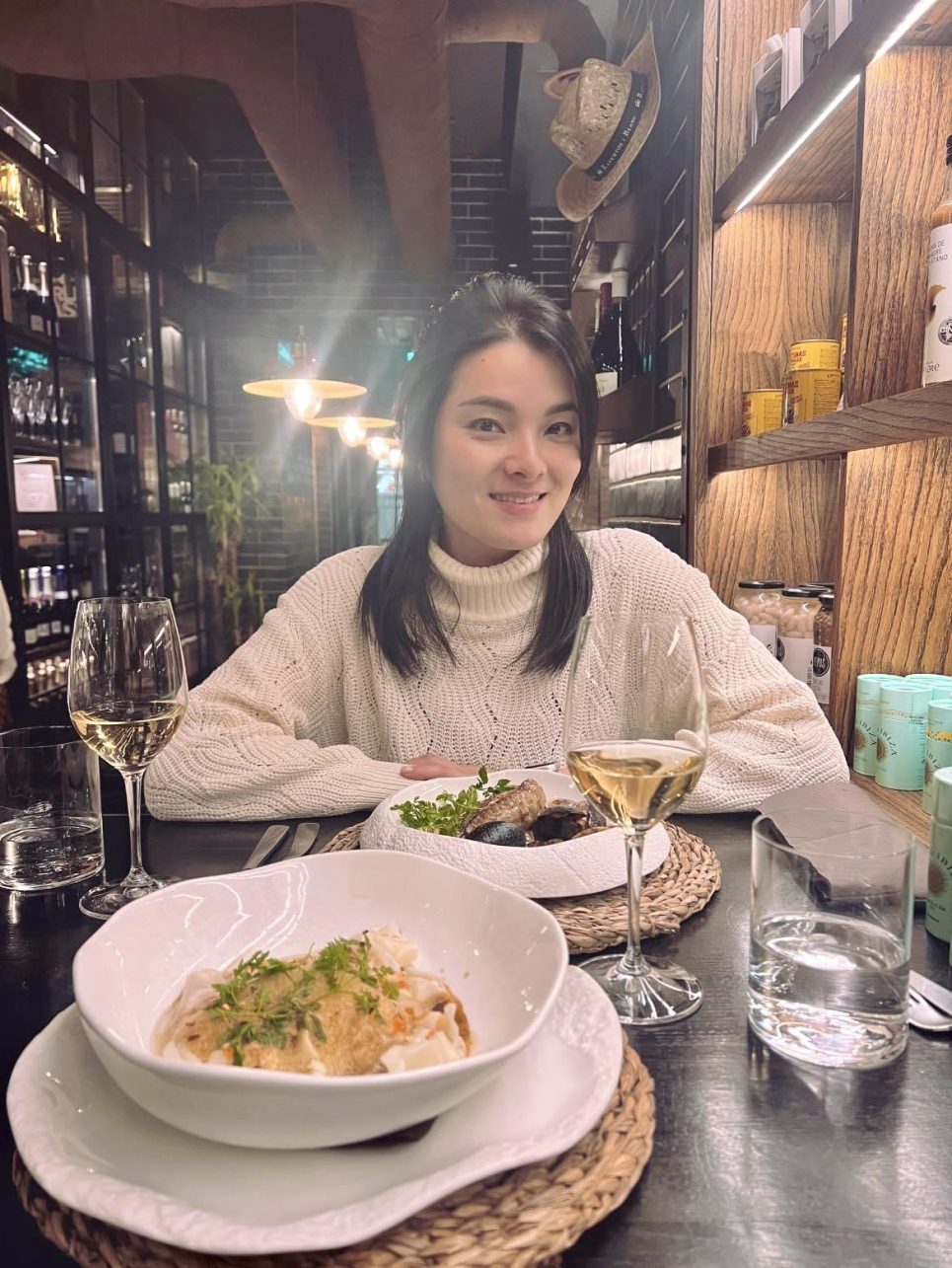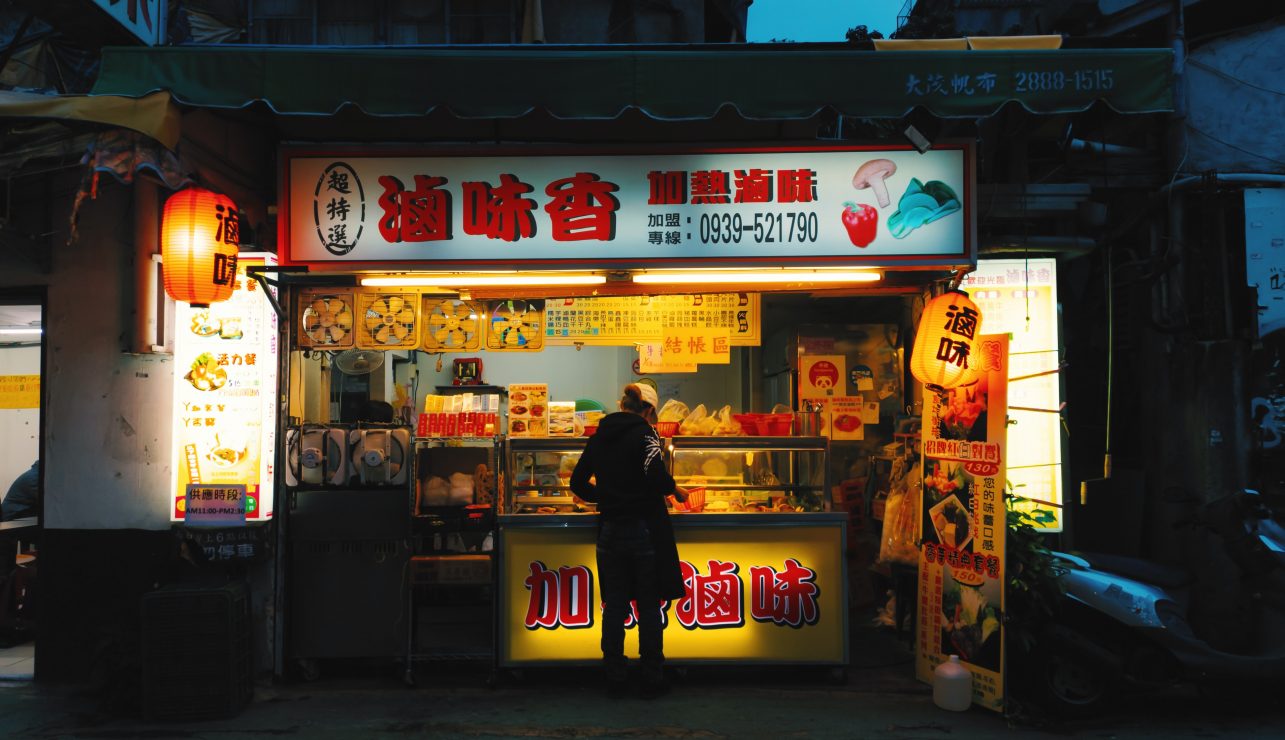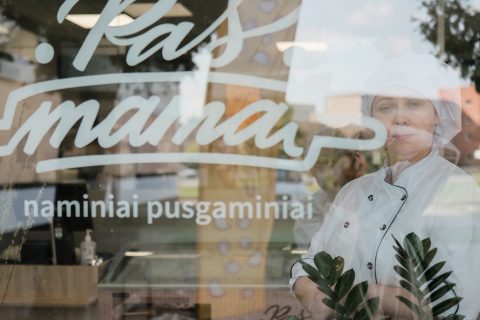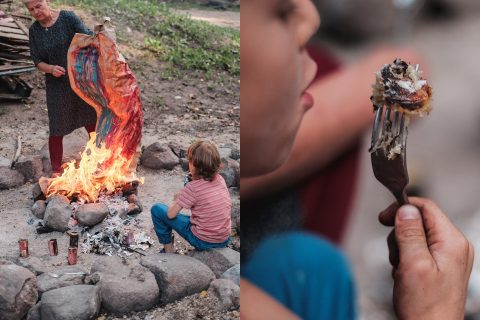Over time, Kaunas has been gradually embracing Asian cuisine, witnessing a rise in numerous restaurants in its city centre, some of which have become longstanding culinary fixtures. To delve deeper into the realm of traditional Asian cuisine, we had a conversation with Julie Ling-Yi Chu, a Taiwanese Ph.D. student at Vytautas Magnus University. Julie’s journey in Lithuania spans six years, during which she spent four in Kaunas, dedicating her time to studies and work in the education field. Originally from Taiwan, Julie’s life journey has taken her through various countries, including Thailand and the United Kingdom. Our discussion revolved around her initial impressions of Kaunas, her deep-seated passion for cooking, and sharing food and the distinctive characteristics of Taiwanese cuisine.

Before we delve into the culinary aspects of the interview, I would like to hear your initial impression of Kaunas.
I came as a tourist for about a week during my initial visit. At that time, everything was pre-reconstruction, but the spaciousness and cleanliness of the place struck me. It was well organized, and the calm atmosphere was quite pleasant. I explored some of the iconic spots, but the visit was short. I returned later to attend a brief summer course at the university, where I delved deeper into the language and culture. This experience exposed me to more historical and academic aspects. That was also when I discovered the significant role of basketball in Lithuania, particularly in Kaunas, where “Žalgiris” is akin to a religion.
After leaving and settling in Vilnius, I began to appreciate Kaunas more uniquely. I had always lived in bustling metropolitans, where people come from all corners of the world, and you need to be open and accepting of everyone and everything. On the other hand, Kaunas intrigued me with its preserved, down-to-earth essence, and there was no shame in being true to its identity. People there had a strong sense of “this is who we are; this is how we do things,” that authenticity resonated with me.
I’m curious to hear if, after your move to Lithuania, you came across any cultural tendencies that particularly intrigued or baffled you.
Before I moved here, I didn’t know much about Lithuanian culture, but I don’t find anything particularly shocking. I’ve noticed parallels between Lithuanian pagan traditions and Taiwanese customs. In our Taiwanese heritage, we have a plethora of old sayings and practices where specific actions are tied to particular times of the year, days of the week, or even the duration since the last rainfall. Still, I’m astonished by people’s eagerness to join in festivities like markets outside during snowfall. It’s intriguing to see how they embrace the cold, long winters, and I believe some of these celebrations are a way to help them cope. Also, I’m charmed by how many people here possess knowledge of natural cues, like when a certain tree blossoms or the specific conditions for finding mushrooms. It reflects a deep connection with nature that often gets lost in the big cities. This connection is something truly beautiful about Lithuania; it allows you to observe the changing seasons and embrace a slower lifestyle closely.
Do you genuinely enjoy cooking, and do you consider food to be a significant part of your life?
Growing up as an expat, one thing that stood out was using food to maintain a connection with our culture within our household. We didn’t always have all the exact ingredients, so improvisation was vital. The significance of certain dishes at particular times of the year was a way to mark those moments in our family’s life. Now that I’ve lived away from my home country for many years, food remains a way to express my culture and personal identity. Since I’ve lived in various places, my cooking tends to be a fusion of different cuisines, which I believe reflects who I am.
I’m genuinely happy to cook for people. We often host cooking parties, especially as we and our friends are moving into our 30s. Home feels cosier, more relaxed, and it’s also more economical and safer. I extend the same hospitality to my neighbours, sharing larger portions of food, and they do the same. Food is a fantastic way to bond with people because everyone eats, even though not everyone loves it to the same extent, but hardly anyone says no to a good meal.

What are your favourite traditional Taiwanese dishes? What about Lithuanian?
Personally, I find myself drawn to the street vendors and markets. Taiwan boasts numerous night markets, a common feature in many Asian cultures, where street food and smaller dishes are plentiful. While I can recreate some of those dishes quite well, there are others that I simply can’t even get close to. What I remember the most are dishes featuring seafood, which makes sense given Taiwan’s island location, and which is something unique and not as prevalent elsewhere. But to pinpoint just one favourite? That’s a tough call.
My all-time favourite Lithuanian dish has to be balandėliai, no doubt about it. It might have something to do with the fact that I’m not the biggest fan of potatoes. (laughs)
You chose to share a recipe for fish cakes. What inspired you to pick this particular dish?
I chose to share this recipe because it’s something I can recreate, and it’s not very similar to what my Lithuanian or European friends have typically tasted. When I make it, they often find it intriguing because the fish cakes don’t retain the traditional shape of a fish, which sparks discussions about why we use it this way, blended. Historically, especially in times when people didn’t live very luxurious lives, they aimed to make the most of every part of the fish or any animal they had to sacrifice. This led to the use of the bits and pieces left behind to create dishes like these fish cakes, which now became pretty popular street food items.
Are there any particular defining features or characteristics that you would say are unique to Taiwanese cuisine?
One interesting difference is our Taiwanese tradition of cooking nearly everything, even vegetables, as opposed to cultures like Japanese or Southeast Asian, where they often consume raw vegetables. This could relate to our climate, where heat and humidity create conditions favouring bacteria growth. So, cooking everything, like stir-frying vegetables, may have been a historical safety and hygiene practice. Another significant aspect is our staple grain, which is rice. However, these days, there’s a strong emphasis on health consciousness. So, you’ll often find various grains mixed into the rice, creating a colourful, more nutritious blend. Taiwanese people are pretty health-conscious, sometimes jokingly referring to themselves as being afraid to die. We make an effort to take care of what we eat.
What stood out to me as well, compared to all of its neighbours in Southeast Asia, is that Taiwan actually has a really big population of vegetarians, and we have such a fascinating concept of vegetarian-only restaurants. For example, we have buffets where you have like fifty options of vegetarian dishes. If you ever visit Taiwan, I recommend trying some vegetarian places, even if you are generally not a fan. You can get vegetarian fine dining with five-course meals, and it’s a fascinating concept. In many places I have lived in, most restaurants have only one or two options for vegetarians on the whole menu, but this is not the case in Taiwan. For vegetarians, I think it’s a sort of paradise.
What do you think shaped Taiwanese cuisine as we know it today?
Taiwan’s culinary traditions are pretty heavily influenced by mainland China. When Chinese immigrants settled in Taiwan, they brought a diverse range of cuisines representing various regions of their homeland. For instance, noodles and buns, typical of Northern Chinese cuisine, are also widely enjoyed in Taiwan but are not as popular in South China. Taiwanese cuisine also shows the influence of Japan due to our history of Japanese colonization for five decades. While we share many similarities with Japanese cuisine, our Taiwanese flavors tend to be heartier and richer, in contrast to the lighter and simpler Japanese dishes that prioritize healthiness and avoid greasy components.
Modern-day Taiwan’s cultural landscape has been enriched by a growing number of Southeast Asian migrants who primarily come for work. These migrant communities have formed fascinating clusters, especially around train stations in various cities. On social media, you’ll frequently see people visiting these areas to connect with their respective communities or to savour a taste of home at local restaurants. You might come across places that focus on cuisines from Indonesia, The Philippines, Vietnam, and Thailand. While the cuisines may have been adapted somewhat to suit local tastes, they still provide a glimpse into the different culinary traditions of those countries. Food, in this context, goes beyond mere sustenance; it carries emotional and nostalgic significance, reflecting the diversity and inclusivity that Taiwanese society proudly embraces.
Taiwan is also home to an indigenous population, albeit relatively small in percentage, but their cuisine and lifestyle stand in stark contrast to the mainstream. Some of the indigenous tribes reside in high-altitude mountain regions and rely on distinct choices of vegetables, fruits, and game meats. In recent times, there’s a growing curiosity among people to understand how the indigenous communities continue their traditional lifestyle. This has led to a unique form of indigenous cuisine tourism in Taiwan, where Taiwanese individuals venture into the mountains to learn about the herbs they gather, the vegetables they consume, and their diverse array of foods. This exploration has been truly eye-opening for me, showcasing the remarkable variety within our relatively small island.
The Taiwanese dish that has achieved immense popularity worldwide is bubble tea, and it has also found its way into Lithuania. This prompted me to ponder whether the bubble tea available here closely resembles its Taiwanese counterpart. Furthermore, I’m curious about the cultural significance of bubble tea in Taiwan. Is it still a beloved and frequently consumed beverage, or has it transitioned from a cultural staple to a global trend with less emphasis on it in Taiwan?
The pioneering bubble tea brand in Lithuania, “Formosa”, is a unique collaboration between two friends—one Taiwanese and one Lithuanian—who crossed paths in the United States. A glance at “Formosa’s” logo reveals the clever incorporation of Taiwan’s shape, depicted with vibrant bubbles, subtly emphasizing its roots. Notably, “Formosa” derives its name from the Portuguese term “ilha formosa,” meaning “beautiful island,” used when they sailed past Taiwan in the seventeenth century. It’s a locally crafted brand and appears to be thriving.
Innovative flavours like jellies and popping boba have become wildly popular, especially among younger generations seeking vibrant and social media-worthy drinks. However, traditional bubble tea is typically Assam black tea with milk, a touch of sugar, and black tapioca bubbles. The extravagant additions came later, and they are now also widely available in the Taiwanese tea shops. Nowadays, a multitude of “shaker tea shops” have sprung up, named after the traditional practice of shaking the tea. This method dates back to the 1980s and 1990s when bubble tea began to take off. These shops served as social hubs for young people, akin to today’s coffee shops, and they remain immensely popular now.
With a growing focus on health, people are seeking alternatives to sugary milk tea, gravitating towards fruity or unsweetened green tea options. However, bubble tea remains an integral part of Taiwanese culture. It’s a common sight in offices, where the 3 pm tea break prompts group orders for snacks. This practice extends to schools, where students, often juggling extracurricular activities, grab bubble tea as a comforting presence, similar to how Europeans might leisurely sip on coffee.
The popularity of Asian restaurants in Lithuania is on the rise, with a strong presence of Chinese, Indian, and sushi establishments. While these cuisines dominate the scene, we’re also seeing more diversity, including Vietnamese and Thai restaurants. Do you think a Taiwanese restaurant would find acceptance within the local context? Is it feasible to operate one both in terms of the cuisine itself and the availability of ingredients for its preparation?
After some cooking parties, my friends and I occasionally entertain the idea of starting our own food truck. Somewhat jokingly, somewhat not, we brainstorm potential offerings, considering what has already gained traction in Lithuania’s culinary landscape. While Taiwanese cuisine boasts a diverse array of dishes, we find it interesting that bao buns, which are not the first thing that comes to mind with Taiwanese food, have gained popularity here. I think that has to do with a familiar burger-like appeal. When you look at one, you can see that it is a bun with a filling of meat or vegetables. I think that’s why it makes sense to Europeans. Meanwhile, with some other Taiwanese dishes, you would have to be a lot more adventurous to try them, and I think it would be much more difficult to get people to like them. The availability of ingredients can also be a challenge, and often, we end up ordering some stuff from Asian supermarkets in Germany or the Netherlands. Though, Lithuania has seen significant progress in ingredient diversity since my arrival. Ultimately, the success of such a venture would depend on various factors, but as a culinary concept, I think it holds promise.
***
Recipe recommendation from Julie – Tian bu la
Tian bu la are Taiwanese fish cakes made with a thick paste which incorporates mild white fish fillets, eggs, and potato or tapioca flour. These fish cakes can take the form of slender cylinders or thick, round discs. Enjoy them as a crispy snack, a convenient on-the-go treat, or as a delightful addition to soy-sauce-based broth.
Ingredients for Tian bu la:
300g white fish
4 tablespoon corn starch
1 egg white
1 teaspoon sugar
1/2 teaspoon salt
1 tablespoon grated ginger
1 spring onion
1/4 cup iced cold water
Dipping Sauce:
1 teaspoon sugar
3 tablespoon ketchup
1 teaspoon rice vinegar
1 teaspoon miso
Begin by cutting the half-thawed fish into smaller chunks for easier blending in a food processor. Blend iced cold water, sliced green onion, and 1 tbsp of grated ginger first.
Next, add fish, sugar, salt, egg white, and cornstarch to the blender. Pulse a few times to break down the fish, then blend until a cohesive paste forms. Test its readiness by dropping a small piece into water; if it floats, it’s ready.
Transfer the fish paste into a piping bag. Heat oil to 150°C in a pot, then pipe the paste into the hot oil, cutting to your desired length. Remove when golden brown and serve with dipping sauce.




